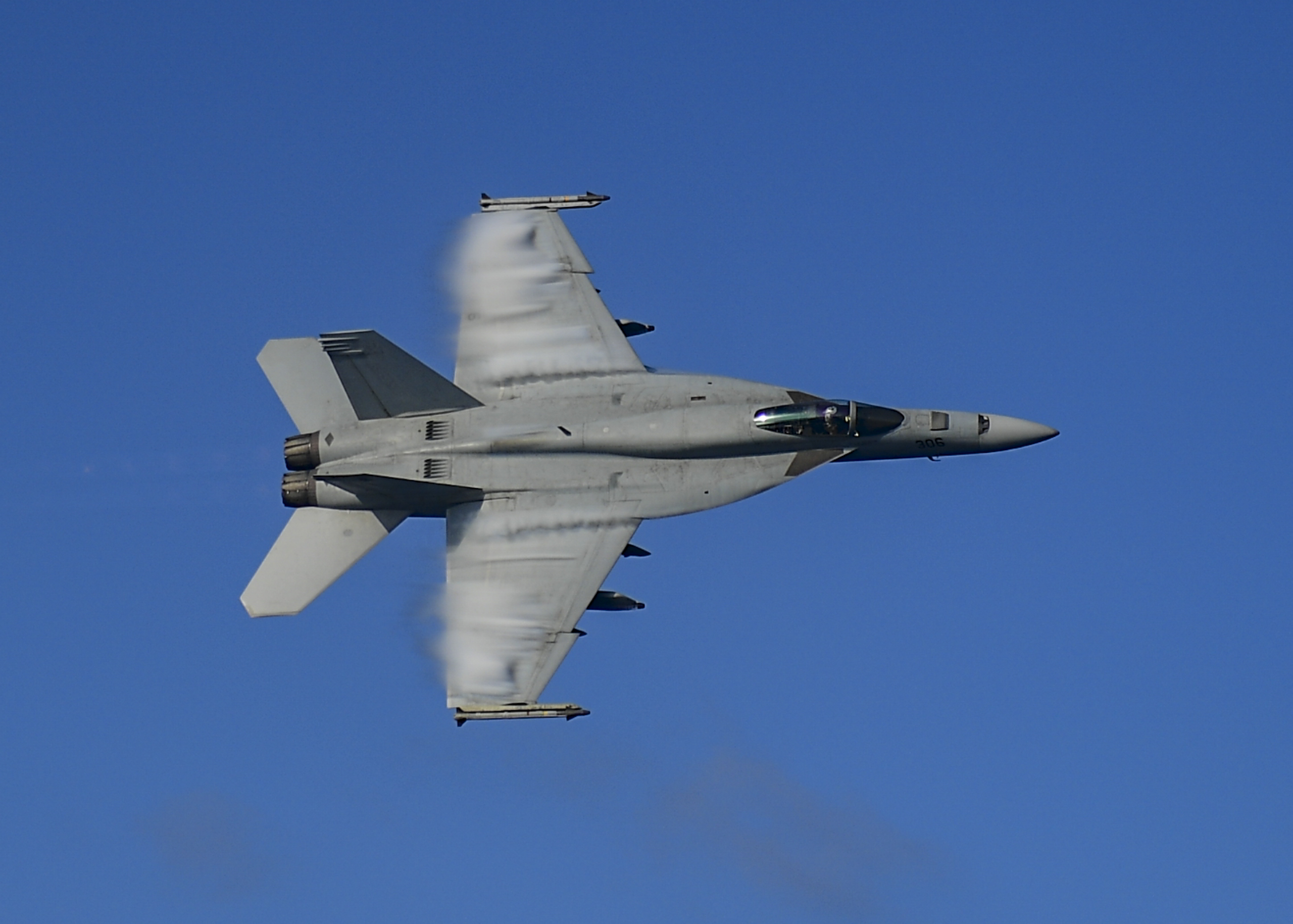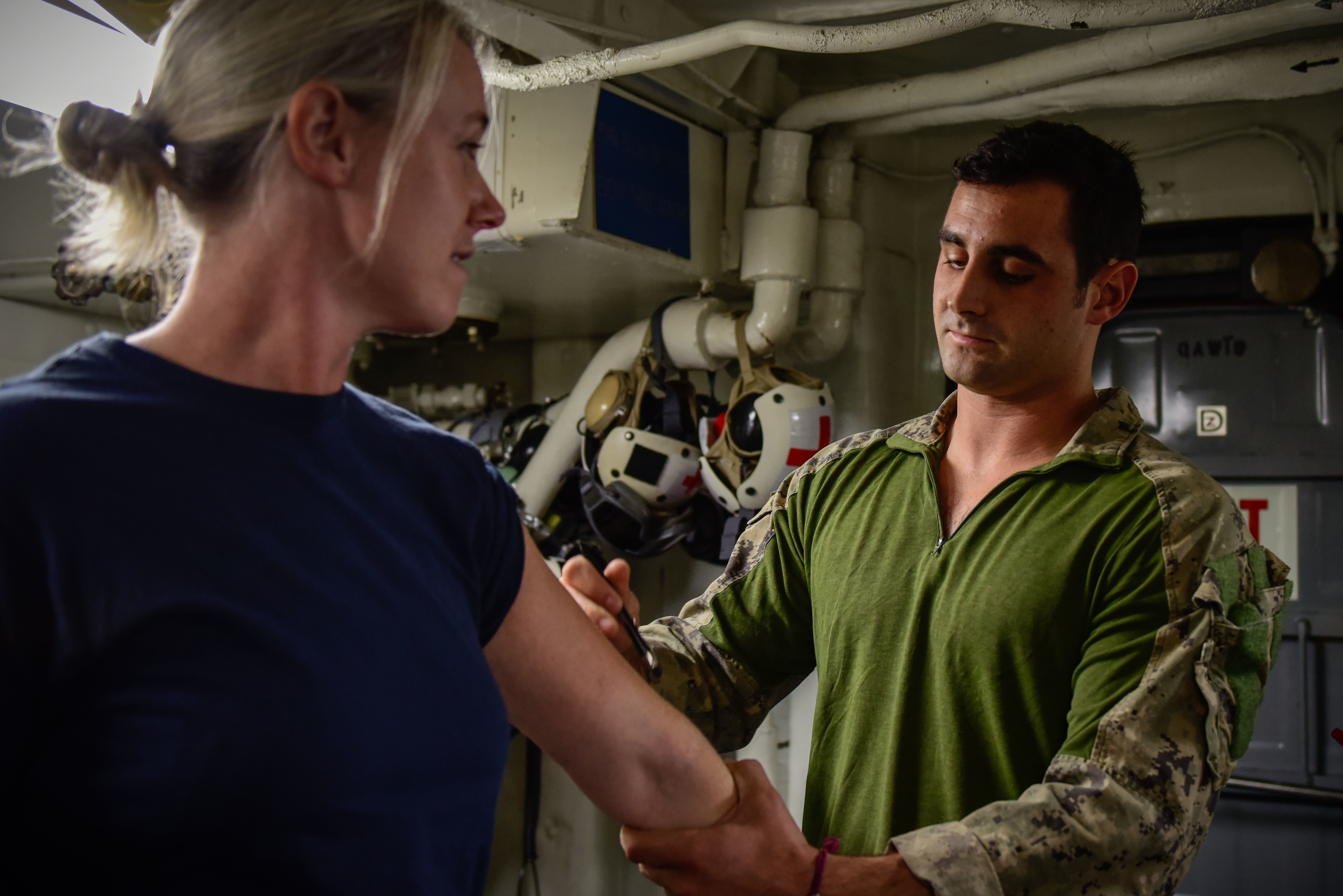
ABOARD USS THEODORE ROOSEVELT, IN THE PERSIAN GULF – Nearly one year after naval flight student training ground to a halt due to soaring rates of physiological episodes among jet aircrew, deployed aviators are vigilant in self-monitoring for PE symptoms and are armed with a hyperbaric oxygen chamber to treat any potential cases while at sea.
Physiological episodes fall into two main categories: hypoxia, when the aviator receives insufficient or contaminated breathing air, or decompression sickness, when the plane’s Environmental Control System fails to maintain proper cabin pressure. PEs have been reported in all types of jets the Navy flies, and last spring the Navy ceased all T-45C Goshawk trainer operations until aviation leadership could take a serious look at what was causing a sharp increase in PE events.
Though the service “never found a smoking gun” in its search for a root cause, the Navy has taken several steps such as replacing parts on the aircraft and implementing new maintenance procedures. PEs are down overall, naval aviation leadership previously told USNI News, but in the Theodore Roosevelt Carrier Strike Group, aircrew and the medical staff on the carrier have a heightened awareness of the danger they still face.
“In the air wing, all the pilots are super sensitive – through their community they know they’ve had issues with their airframes and they know that people that have had issues were not necessarily treated in a timely manner. So they’re super sensitive to it, and in fact I would say because of that we probably get a lot of false negatives. But that’s okay, it’s better for them,” Theodore Roosevelt Carrier Strike Group senior medical officer Cmdr. George Newton told USNI News during a visit to the CSG at the end of its time in U.S. 5th Fleet. The strike group has since chopped into U.S. 7th Fleet for its transit home to the West Coast.
Newton said Carrier Air Wing 17 aboard USS Theodore Roosevelt (CVN-71) has not had any confirmed PEs that required treatment in the hyperbaric chamber yet; “however, we’ve had some folks with some pretty significant symptoms that took some repeat evaluations. But the pilots are super sensitive – we tell them, having the slightest symptom, let us evaluate you, let us track it that way if we determine it’s something that can be treated then we’ll treat.”
As of March 23, the air wing had 11 potential PE events that were reported, with some being potential decompression sickness events and some being potential hypoxia events. All aircrew were placed on oxygen during the medical evaluation and fully recovered without the use of the hyperbaric oxygen chamber or other significant medical intervention, Newton told USNI News. For comparison, USS George H.W. Bush (CVN-77) and Carrier Air Wing 8 experienced 13 physiological episodes during its seven-month deployment last year, USNI News previously reported.
The last five carrier strike group deployments, including TR’s, have included the hyperbaric chamber and an accompanying team of Navy divers to operate the chamber if needed. Bush and USS Nimitz (CVN-68) were outfitted with the capability in their deployments last year, and USS Carl Vinson (CVN-70) deployed with the chamber and dive team both last year and in its ongoing surge deployment.

Navy Diver 1st Class Wayne Shearer, the chamber supervisor and head of the three-man team from Mobile Diving and Salvage Unit 1, said his team is “a tool that’s in the back pocket of every aviator onboard, and whether they decide to use it or not is up to them. All we can tell them is they’re not going to get any better taking aspirin or flying again. This is the only way to get better,” particularly in the case of decompression sickness, since the pain the aviators would experience is due to an air bubble in their bloodstream that won’t easily resolve itself.
In a nod to the seriousness with which the team approaches all potential PE diagnoses, Shearer said he assumes every reported symptom will require hyperbaric chamber treatment, and his team is ready to act every single time, until he, Newton or a flight surgeon rule out the chamber as a needed course of treatment.
Though medical research into the aviators’ PE problems is ongoing, Shearer said that among divers a key challenge is that “every person’s body is different. [One diver] may have held his breath for one second longer than [his dive partner] did on ascent. So depending on what happens in the aircraft, the pilots are not going to be the same 100-percent of the time, their bodies aren’t going to be the same. The tell-tale sign, especially in those dual-seat aircraft, is, hey, is this how your partner normally acts, or does he seem off to you? That’s a huge PE red flag for the divers for us to press.”

Newton agreed and said his medical team has been persistent about tracking down not only aircrew for follow-up evaluations but also others in their squadrons about behavioral changes they may have observed.
Though Newton was quick to note that the problem resides in the planes themselves, Shearer said they still recommended aircrew be proactive in making sure they are well rested, hydrated and in good health before flight to reduce the likelihood of experiencing a PE. Shearer said hydration is especially important due to its effect on blood vessels and their ability to allow air bubbles to move freely.
When an aviator notices something isn’t right during a flight – sometimes a headache, tingling or numbness in the hands, grogginess or other symptoms – the TR strike group’s protocol is to report the symptoms back to the ship while still in the air. When a call comes in, the flight surgeon would be ready to meet the aircrew at the flight deck battle dressing station when they land. After an initial evaluation, the patient would be brought down to the medical staff, who, along with Shearer’s team, would conduct neurological and other exams to determine the best course of treatment. The medical teams would also have access to the aircrew’s slam sticks – a device kept in all aviators’ flight suit pockets that records cabin pressure – and other gear that would provide clues as to what took place during the flight. Between the data from the jet and the exam on the patient, the medical staff and divers may recommend a wait-and-see approach, may recommend treatment in the hyperbaric chamber – which lasts about six hours – or may recommend another course of action.
Shearer said the hyperbaric chamber on Theodore Roosevelt was only used twice for hyperbaric pressure tolerance tests for special operations candidates – though he and Newton said one of the other carriers actually used the chamber to treat a case of carbon monoxide poisoning in sailor working onboard the carrier.
Overall, Shearer said he was impressed with the way the carrier strike group leadership handled the addition of the hyperbaric chamber and the dive team and said he hoped others would follow the same operational plans to ensure the strike group and the dive team were ready to respond at any time to a medical event.
“Low-footprint, the fact that we integrated well with the medical side here, and having those [operational and tactical plans] readily available to us,” Shearer said of their reasons for success.





